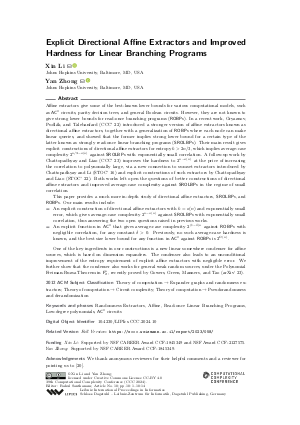@InProceedings{li_et_al:LIPIcs.CCC.2024.10,
author = {Li, Xin and Zhong, Yan},
title = {{Explicit Directional Affine Extractors and Improved Hardness for Linear Branching Programs}},
booktitle = {39th Computational Complexity Conference (CCC 2024)},
pages = {10:1--10:14},
series = {Leibniz International Proceedings in Informatics (LIPIcs)},
ISBN = {978-3-95977-331-7},
ISSN = {1868-8969},
year = {2024},
volume = {300},
editor = {Santhanam, Rahul},
publisher = {Schloss Dagstuhl -- Leibniz-Zentrum f{\"u}r Informatik},
address = {Dagstuhl, Germany},
URL = {https://drops.dagstuhl.de/entities/document/10.4230/LIPIcs.CCC.2024.10},
URN = {urn:nbn:de:0030-drops-204060},
doi = {10.4230/LIPIcs.CCC.2024.10},
annote = {Keywords: Randomness Extractors, Affine, Read-once Linear Branching Programs, Low-degree polynomials, AC⁰ circuits}
}

 Creative Commons Attribution 4.0 International license
Creative Commons Attribution 4.0 International license




















